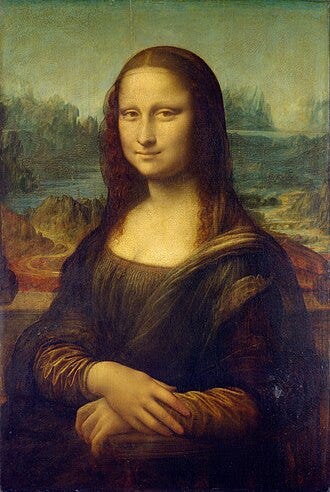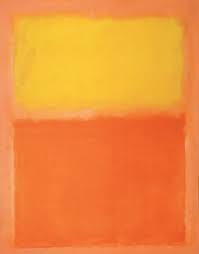“You say grace before meals. All right. But I say grace before the concert and the opera, and grace before the play and pantomime, and grace before I open a book, and grace before sketching, painting, swimming, fencing, boxing, walking, playing, dancing and grace before I dip the pen in the ink.”
―G.K. Chesterton
This post will be a detour from my usual #acnotes , however I may recommend something more than music this time. Humour me, if you have the time and patience. Or else, you’re free to skip.
Last weekend, we were at the NGMA Art Gallery in Bangalore to see Caravaggio’s masterpiece - ‘Mary Magdalene in Ecstasy’. The place wasn’t so crowded, however there was a sizeable number of people walking in to view this painting. The irony was that the queue was bigger for the VR experience** (I’ll get back to this later). This was the first time an original painting of Michelangelo Merisi da Caravaggio was brought to India. Perhaps, for those who don’t know much about this painting like me, a google search would speak volumes about this masterpiece. So, I won’t delve any further into the trivia part of it. While I wish to keep aside my reaction or response to the Italian baroque style painting, since I wasn’t really in a state of mind to engage with the art, leave alone respond or resonate. That said, what I wish to share here, is my observation and theory about what makes a painting a masterpiece? Or, if I’ve to extend that a little further - what makes a dish/recipe delectable? What makes a song or album a chartbuster/classic?
At this moment, I wish to share an incident that happened to someone I know. A few years back, they had gone to see THE Mona Lisa at the Louvre Museum in Paris. Well, as expected there was this long queue and in company stood - anticipation. Or a certain expectation that was set based on what they had heard about the painting. Perhaps, even read in the books at a fleeting glance. So, there they were in that large room, amidst a huge crowd with most hands raised not in reverence but holding their phone cameras to archive this moment. In fact, some held the cameras facing them with the Mona Lisa beside, some gaped at the portrait from a distance, some were there to see what the crowd was seeing - part of the herd. Then it was this friend’s chance to get a closer look at the painting. S/he looked at it. The tic and toc of the seconds were echoing in their head as they watched. Time, they thought, would come to a screeching halt. People standing around would freeze and become statues. They assumed there could be a veil of mist dissolving into thin air between them and the painting as they watched. And it will be a revelation. A life altering experience. A moment that would make their jaws drop to the floor. <record scratch> Reality bites. Nothing of the aforementioned came to pass. In fact, they saw the painting and shrugged. In no particular order, these thoughts rushed through their mind: What was the hype all about? What did I miss? The long queues, the huge crowds flocking opposite to the wall, the people clicking pictures with or of the portrait. What was so special or unique about this painting? Truth be told, they felt this was some kind of sham. There was nothing exceptional, according to them.
Cut to, a story I heard many years back at a Church. I will surely credit the speaker once I get to know the name (still trying to find out). So, the story dates back to early 80s, at his neighbourhood, where a middle aged woman used to show up every Friday to clean the copper vessels. For those who own or have previously used copper vessels, you know the special care it needs for its maintenance. Back then, there used to be these people who would visit houses or neighbourhoods to clean such vessels using tamarind and ash to bring a shine and gloss. Now imagine the setting - early morning around 7am, a street corner where this lady is sitting on a large stone or stool, people queued up before her with their vessels, and she is taking turns to shine each one’s vessel - one after another. One day, this speaker/gentleman who was in his teens looked up to her like she was some magician, mustered up his courage, walked up to her to find out the secret behind this trade. He waited patiently till she was done with the last vessel. He almost saw his reflection on the vessel as she lowered it from her face and plonked it on the floor. And he asked her, if she knew how with just tamarind and ash she is able to conjure up such magic. Tat came her reply “If I knew that, why would I still be doing this job, thambi?*”. So, after a while he himself figured that it was all about that combination and the right amount of pressure and scrubbing that leads to such results. After all, it was being seasoned in that specific task and applying that practice time, time and again, which leads to such alchemy.
Now the reason I shared the above story is: perhaps, this is what happens with how we consume art as well. We engage with different forms of art when we aren’t really in a state of mind that’s aware or present. We indulge in a delicacy when we are hungry, maybe, but not in the mindset to experience what’s served, mindfully. In this time and age where we are swayed by so many distractions, to be attentive and curious to observe something is a major task. More importantly, each one of us has this constant chatter in our heads that is buzzing through and through to keep up with everything that’s happening around us. With an effort to stay updated, we are enduring information over-load, to keep ourselves entertained we are prancing from one mental stimuli to another. We seldom know what boredom means. Worse is we rarely make room for thinking. Hence, we jump to conclusions. In short, we judge.
“Thinking is difficult that’s why most people judge.”
- Carl Jung
The quote above perfectly captures what most of us do. We use our preconceived notions, past experiences and biases - what we have previously endured, read or heard to judge something we’ve come across. We use short cuts. While I am tempted to drop a buzz word (s) that’s trending since a last few months - brain rot, I won’t. Instead, I’ll share my observations. I feel we have, or at least, I have resorted to the familiar. The songs I grew up listening to, the books I’ve read - I’m rereading, the choice of food remains the same with little or no will to try something new, watch reruns of old sitcoms or movies. Perhaps, the digital screens, the information overkill and the pace at which the world around is racing is already keeping my mind on its toes. So, caught up in this cycle, I choose the ones that demand little or no effort. It’s more or less like gulping down pre-chewed food. However, I’m trying my best to move away from the aforementioned. It will take some time, but I’m here for the long haul.
So, you’ve read this far and I am guessing you might be wondering what is the conclusion then? Well, I have an approach and this might evolve over time. I promise to keep you posted when it does. That said, at the moment, this is my approach. Now, if you could kindly flex your thumb a bit and scroll back to the top, you will find the quote I began this post with.
For those who aren’t really in the mood to flex, no worries, here it is, once again:
“You say grace before meals. All right. But I say grace before the concert and the opera, and grace before the play and pantomime, and grace before I open a book, and grace before sketching, painting, swimming, fencing, boxing, walking, playing, dancing and grace before I dip the pen in the ink.”
One way of looking at these lines by G.K. Chesterton is to pause, pray (if you may) or take a deep breath, and then indulge in the experience. Of course, the traditional way of saying grace is to acknowledge the opportunity and express gratitude for the meal. Now, how about we see this opportunity in engaging with this piece of art as a source of sustenance for our mind and soul. In other words, soul food. Also, while pressing pause just before the moment, it’s also a way of decluttering your mind and making space for what you are about to consume. Maybe, the below mentioned could add more sense to the theory I’m trying to float. Read it slowly. Read it again, if need be. Read, quieting your mind for a moment.
“I hope that you will listen, but not with the memory of what you already know; and this is very difficult to do. You listen to something, and your mind immediately reacts with its knowledge, its conclusions, its opinions, its past memories. It listens, inquiring for a future understanding.
Just observe yourself, how you are listening, and you will see that this is what is taking place. Either you are listening with a conclusion, with knowledge, with certain memories, experiences, or you want an answer, and you are impatient. You want to know what it is all about, what life is all about, the extraordinary complexity of life. You are not actually listening at all.
You can only listen when the mind is quiet, when the mind doesn't react immediately, when there is an interval between your reaction and what is being said. Then, in that interval there is a quietness, there is a silence in which alone there is a comprehension which is not intellectual understanding.
If there is a gap between what is said and your own reaction to what is said, in that interval, whether you prolong it indefinitely, for a long period or for a few seconds - in that interval, if you observe, there comes clarity. It is the interval that is the new brain. The immediate reaction is the old brain, and the old brain functions in its own traditional, accepted, reactionary, animalistic sense.
When there is an abeyance of that, when the reaction is suspended, when there is an interval, then you will find that the new brain acts, and it is only the new brain that can understand, not the old brain”
―J. Krishnamurti
Thank you for your time and patience. I’ll try to close my argument at the earliest.
At this juncture, I wish to bring to your notice the relevance of having benches or seating at art galleries. The whole purpose of adding a piece of furniture before the work of art. Next time, while you are about to indulge in any form of art. This includes listening to a song or album, viewing a painting, reading a book or poem, or even something as simple as sitting down to taste something new for the first time. Visualize this bench and imagine you’re reclining there for a moment before your indulgence. If you wish to call that being mindful or practicing mindfulness, so be it.
We have a lot of words and we are never in shortage of terming something to make it seem prolific. Anyway, I guess I’m digressing. I’ll close with an example - one of the first #acnotes I wrote:
I grew up listening to this song. More or less, from my high school days I guess. And never once did it strike me that it was a song about Van Gogh. In fact, all along I thought this song was called Starry Night and it was sung by John Denver. It was much much later that I got to know that Don McLean was the one who wrote this song. And that one time I listened to it which really hit hard was at the end of the 2017 movie - Loving Vincent. This time, towards the end of the movie, I was almost primed for the moment. The tragic story of Vincent Van Gogh and his end complemented by the song, shattered me completely. I wept. I could feel the pain. There was a certain sense of empathy, instead of sympathy. The bench was that pause in the end of the movie. A brief moment after the portrait of Van Gogh and just before the end credits. I heaved a sigh of relief. And as the song played, I broke down. I watched the credits roll with misty eyes.
In a few days, the The Real Van Gogh Immersive Experience is expected to arrive in Bangalore. And I heard through my friends that the VR experience** at the NGMA on Caravaggio’s paintings elevated the experience altogether. While I haven’t tried both, I guess that’s one way to engage and understand art too. Especially, in these times of short attention spans. In person or virtually, either way, I believe art while you look at it from afar - it only lets you gaze inwardly. It begins with a reflection of your mind chatter as I mentioned earlier. Give it some time. Hush it down. And then, maybe, you’ll see what you the artist wants you to see/listen/taste.
Some Reccos as promised earlier:
Caravaggio - Master of Light
3. Lianne La Havas - "Starry Starry Night" from Loving Vincent
Thank you for reading. Is there a way you approach art/music/poetry/food?
Feel free to share in the comments.
Open to discuss.








Love this piece about taking the time to consume a piece of artwork. While our memories and experiences do give us some perspective, it is important to try to carve out a little space away from ourselves to experience it.
P.S: Have you listened to ‘I Don’t know How to Love Him’ from Jesus Christ Super Star? I think of this song every time I come across Caravaggio’s Mary Magdalene in Ecstasy
Hey
You have analysed in depth the mind of the human and it’s behaviour nicely.
I enjoyed reading about the small episode of the hype created about the Monalisa painting . I
Humans have Monkey mind 🙈 .
So………